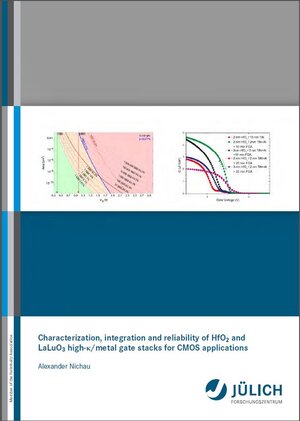
×
![Buchcover ISBN 9783893368983]()
Characterization, integration and reliability of HfO2 and LaLuO3 high- /metal gate stacks for CMOS applications
von Alexander NichauThe continued downscaling of MOSFET dimensions requires an equivalent oxide
thickness (EOT) of the gate stack below 1 nm. An EOT below 1.4 nm is hereby enabled
by the use of high-?/metal gate stacks. LaLuO3 and HfO2 are investigated as
two different high-? oxides on silicon in conjunction with TiN as the metal electrode.
LaLuO3 and its temperature-dependent silicate formation are characterized by
hard X-ray photoemission spectroscopy (HAXPES). The effective attenuation length
of LaLuO3 is determined between 7 and 13 keV to enable future interface and diffusion
studies. In a first investigation of LaLuO3 on germanium, germanate formation
is shown.
LaLuO3 is further integrated in a high-temperature MOSFET process flow with
varying thermal treatment. The devices feature drive currents up to 70µA/µm at
1µm gate length. Several optimization steps are presented. The effective device
mobility is related to silicate formation and thermal budget. At high temperature,
the silicate formation leads to mobility degradationdue to La-rich silicate formation.
The integration of LaLuO3 in high-T processes delicately connects with the
optimization of the TiN metal electrode. Hereby, stoichiometric TiN yields the best
results in terms of thermal stability with respect to Si-capping and high-? oxide.
Different approaches are presented for a further EOT reduction with LaLuO3 and
HfO2. Thereby the thermodynamic and kinetic predictions are employed to estimate
the behavior on the nanoscale. Based on thermodynamics, excess oxygen in the gate
stack, especially in oxidized metal electrodes, is identified to prevent EOT scaling
below 1.2 nm. The equivalent oxide thickness of HfO2 gate stacks is scalable below
1 nm by the use of thinned interfacial SiO2. The prevention of oxygen incorporation
into the metal electrode by Si-capping maintains the EOT after high temperature
annealing. Redox systems are employed within the gate electrode to decrease the
EOT of HfO2 gate stacks. A lower limit found was EOT = 5 °A for Al doping inside
TiN. The doping of TiN on LaLuO3 is proven by electron energy loss spectroscopy
(EELS) studies to modify the interfacial silicate layer to La-rich silicates or even
reduce the layer.
thickness (EOT) of the gate stack below 1 nm. An EOT below 1.4 nm is hereby enabled
by the use of high-?/metal gate stacks. LaLuO3 and HfO2 are investigated as
two different high-? oxides on silicon in conjunction with TiN as the metal electrode.
LaLuO3 and its temperature-dependent silicate formation are characterized by
hard X-ray photoemission spectroscopy (HAXPES). The effective attenuation length
of LaLuO3 is determined between 7 and 13 keV to enable future interface and diffusion
studies. In a first investigation of LaLuO3 on germanium, germanate formation
is shown.
LaLuO3 is further integrated in a high-temperature MOSFET process flow with
varying thermal treatment. The devices feature drive currents up to 70µA/µm at
1µm gate length. Several optimization steps are presented. The effective device
mobility is related to silicate formation and thermal budget. At high temperature,
the silicate formation leads to mobility degradationdue to La-rich silicate formation.
The integration of LaLuO3 in high-T processes delicately connects with the
optimization of the TiN metal electrode. Hereby, stoichiometric TiN yields the best
results in terms of thermal stability with respect to Si-capping and high-? oxide.
Different approaches are presented for a further EOT reduction with LaLuO3 and
HfO2. Thereby the thermodynamic and kinetic predictions are employed to estimate
the behavior on the nanoscale. Based on thermodynamics, excess oxygen in the gate
stack, especially in oxidized metal electrodes, is identified to prevent EOT scaling
below 1.2 nm. The equivalent oxide thickness of HfO2 gate stacks is scalable below
1 nm by the use of thinned interfacial SiO2. The prevention of oxygen incorporation
into the metal electrode by Si-capping maintains the EOT after high temperature
annealing. Redox systems are employed within the gate electrode to decrease the
EOT of HfO2 gate stacks. A lower limit found was EOT = 5 °A for Al doping inside
TiN. The doping of TiN on LaLuO3 is proven by electron energy loss spectroscopy
(EELS) studies to modify the interfacial silicate layer to La-rich silicates or even
reduce the layer.


